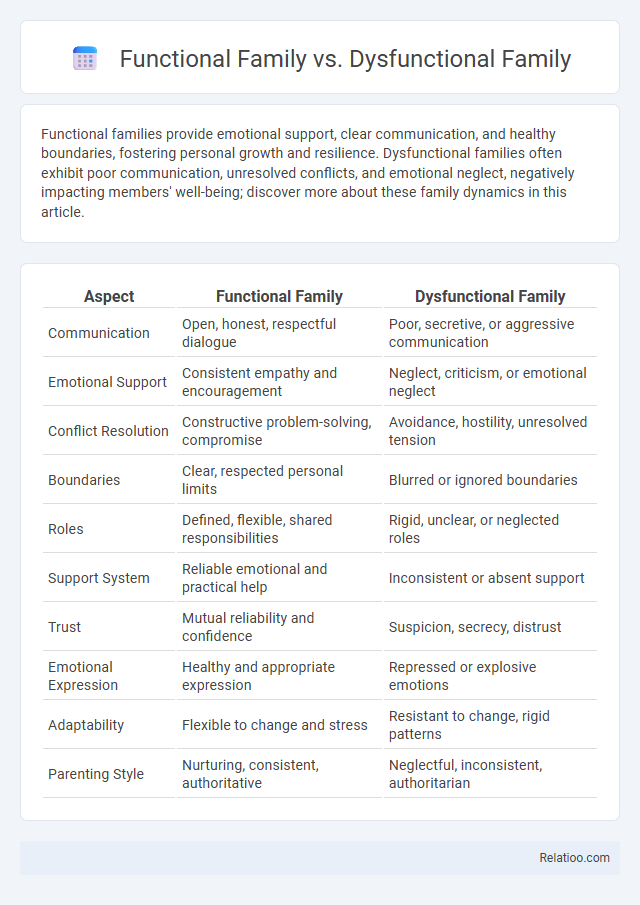Functional families provide emotional support, clear communication, and healthy boundaries, fostering personal growth and resilience. Dysfunctional families often exhibit poor communication, unresolved conflicts, and emotional neglect, negatively impacting members' well-being; discover more about these family dynamics in this article.
Table of Comparison
| Aspect | Functional Family | Dysfunctional Family |
|---|---|---|
| Communication | Open, honest, respectful dialogue | Poor, secretive, or aggressive communication |
| Emotional Support | Consistent empathy and encouragement | Neglect, criticism, or emotional neglect |
| Conflict Resolution | Constructive problem-solving, compromise | Avoidance, hostility, unresolved tension |
| Boundaries | Clear, respected personal limits | Blurred or ignored boundaries |
| Roles | Defined, flexible, shared responsibilities | Rigid, unclear, or neglected roles |
| Support System | Reliable emotional and practical help | Inconsistent or absent support |
| Trust | Mutual reliability and confidence | Suspicion, secrecy, distrust |
| Emotional Expression | Healthy and appropriate expression | Repressed or explosive emotions |
| Adaptability | Flexible to change and stress | Resistant to change, rigid patterns |
| Parenting Style | Nurturing, consistent, authoritative | Neglectful, inconsistent, authoritarian |
Defining Functional and Dysfunctional Families
Functional families provide a supportive environment where open communication, reliable emotional support, and consistent boundaries foster healthy development. Dysfunctional families exhibit patterns of conflict, neglect, or inconsistent behavior that hinder effective coping and emotional growth. Family systems theory emphasizes the interconnected roles and dynamics influencing both functional and dysfunctional family interactions.
Core Characteristics of a Functional Family
Functional families exhibit clear communication, emotional support, and consistent boundaries that foster healthy relationships and personal growth. You benefit from trust, respect, and effective problem-solving strategies that create a stable environment for all members. In contrast, dysfunctional families display patterns of neglect, poor communication, and unresolved conflict, disrupting the family system's balance.
Common Traits of a Dysfunctional Family
Dysfunctional families often exhibit patterns of poor communication, inconsistent boundaries, and emotional neglect or abuse, leading to unresolved conflicts and chronic stress among members. These families may struggle with roles that are either rigid or ambiguous, fostering an environment where trust and emotional support are deficient compared to functional families. Unlike functional family systems that promote healthy interaction and mutual respect, dysfunctional systems perpetuate behaviors that undermine individual growth and emotional well-being.
Communication Patterns in Both Family Types
Functional families exhibit open, clear, and respectful communication patterns that foster trust and emotional security, helping members express needs and resolve conflicts effectively. Dysfunctional families often display inconsistent, unclear, or hostile communication, leading to misunderstandings, emotional distance, and unresolved tensions that hinder personal growth. Understanding these communication dynamics in your family system can empower you to cultivate healthier interactions and stronger relationships.
Emotional Support and Mental Health Impacts
Functional families provide consistent emotional support, fostering a secure environment that promotes positive mental health and resilience. Dysfunctional families often lack this support, leading to increased stress, anxiety, and potential long-term emotional trauma for members. Understanding your family system's dynamics is crucial for addressing mental health challenges and seeking appropriate therapeutic interventions.
Parenting Styles and Their Effects
Functional families exhibit authoritative parenting characterized by warmth, clear boundaries, and consistent discipline, fostering children's emotional stability and social competence. Dysfunctional families often display authoritarian or neglectful parenting styles, leading to increased behavioral problems, low self-esteem, and impaired emotional regulation in children. Family systems theory underscores how parenting styles shape family dynamics and individual development through continuous feedback loops influencing attachment patterns and communication styles.
Conflict Resolution Strategies Compared
Functional families employ effective conflict resolution strategies such as open communication, active listening, and collaborative problem-solving to maintain harmony and strengthen relationships. Dysfunctional families often struggle with unresolved conflicts characterized by blame, avoidance, or aggression, which escalate tensions and hinder emotional growth. Your understanding of family systems highlights that the structure and interaction patterns influence how conflicts are addressed, making systemic approaches crucial for fostering healthy communication and conflict resolution.
Family Roles and Boundaries Explained
Functional families maintain clear and flexible boundaries, enabling members to assume well-defined roles such as nurturer, provider, or mediator, fostering healthy communication and emotional support. Dysfunctional families exhibit rigid or enmeshed boundaries, leading to blurred roles that cause confusion, conflict, and emotional neglect or over-dependence among members. Family systems theory emphasizes the dynamic interplay of roles and boundaries, highlighting how balanced structure promotes stability, while dysfunction arises from role conflicts and boundary violations.
Consequences for Child Development
Children raised in functional families typically experience emotional stability, secure attachment, and healthy social development, fostering resilience and effective coping skills. Dysfunctional families often expose children to inconsistent parenting, emotional neglect, or conflict, which can result in anxiety, behavioral problems, and impaired cognitive growth. Family systems theory highlights how interactions and roles within the family unit influence a child's psychological well-being, emphasizing the need for balanced boundaries and communication to support optimal development.
Steps Toward Building a Functional Family
Building a functional family involves establishing open communication, setting clear boundaries, and fostering emotional support among members to promote healthy relationships. Dysfunctional family systems often lack these elements, leading to unresolved conflicts, poor communication, and emotional disconnection. You can transform your family dynamic by prioritizing trust, practicing empathy, and encouraging accountability across all interactions.

Infographic: Functional Family vs Dysfunctional Family
 relatioo.com
relatioo.com